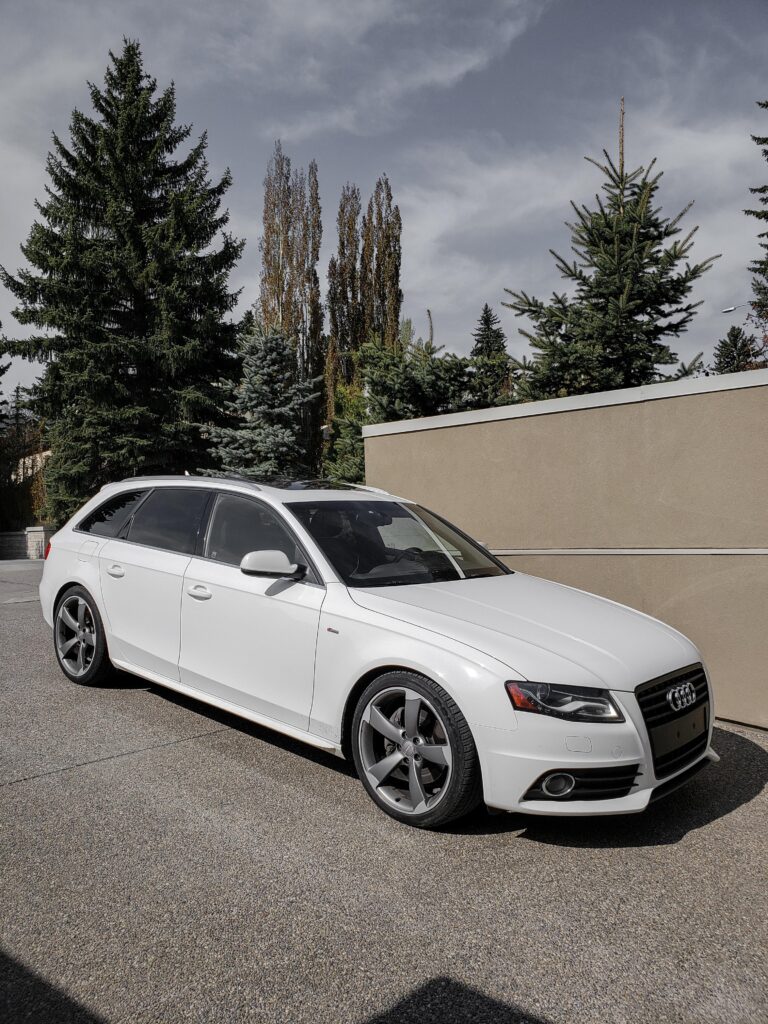The Audi A4, a symbol of German engineering and luxury, is more than just a car; it’s a statement. Every component, every detail, and every drop of fluid in this masterpiece is meticulously chosen to ensure unparalleled performance. One such crucial component is the transmission fluid.
Key Takeaways:
- Transmission Fluid Importance: The right transmission fluid is crucial for the optimal performance of the Audi A4, ensuring smooth gear shifts and protecting against wear.
- Audi A4 Evolution: The Audi A4 has undergone significant transformations over its generations, from the pioneering B5 to the modern B9 facelift, each with specific transmission fluid needs.
- Transmission Types: Audi A4 models across different generations have employed various transmission systems, including manual, Tiptronic, DSG, and CVT.
- Fluid Capacities: The transmission fluid capacity varies depending on the generation and specific transmission type. For instance, the B9 5th Gen requires around 3.7 to 4 quarts, while the B8 4th Gen can take up to 10.1 pints.
- Maintenance Recommendations: It’s generally advised to change the transmission fluid in an Audi A4 every 40,000 to 50,000 miles, though consulting the vehicle’s manual or a mechanic is essential.
- Cost Considerations: Changing the transmission fluid in an Audi A4 typically costs between $150 to $350, but prices can vary based on location and service provider.

The right transmission fluid doesn’t just lubricate; it ensures smooth gear shifts, protects against wear, and maintains the car’s optimal driving dynamics.
But the Audi A4 isn’t a static entity. Over the years, it has evolved, adapted, and transformed, much like the ethos of the brand itself.
From its inception in the late ’90s with the B5 generation to the sleek and modern B9 facelift of today, the A4 has seen revolutions in design, technology, and engineering. Each generation brought with it new challenges and requirements, especially in the realm of transmission fluid.
2017 – Now Audi A4 B9 Transmission Fluid Capacity and Fluid Type
The B9 generation, spanning from 2017 to the present, represents a significant leap in Audi’s engineering prowess. With advancements in technology and design, the transmission systems of these models have been refined to offer smoother performance and enhanced efficiency.

Here’s a detailed look at the transmission types and their respective fluid capacities for this generation:
| Transmission | Fluid Capacity | Fluid Type |
| 8-speed automatic 0D5 | 9.5 quarts (9 liters) | G060162A2 |
| 7-speed DTC transmission (DSG 0CK and 0CL and 0CJ) | Automatic part – 4.6 quarts (4.4 liters) Manual part – 4 quarts (3.8 liters) | G055529A2 – For automatic portion. G052549A2 – For manual portion. |
| 6-speed manual 0CX | 3.8 pints; 2 quarts (1.8 liters) | G052549A2 |
| 6-speed manual 0CS | 2.65 quarts (2.5 liters) | G052549A2 |
| 6-speed manual (0DJ, Gearbox code – PZH, RYH, RYJ, RYK, RYL, RYN) | 3.8 pints; 2 quarts (1.8 liters) | G052549A2 |
| 6-speed manual transmission (0DJ, Gearbox code – PZE, PZF, PZG, PZJ, RKD) | 2.65 quarts (2.5 liters) | G052549A2 |
- 7-speed MT Portion 0CL transmission:
- Fluid Capacity: Total fill of 3.7 quarts (3.5 liters).
- Fluid Type: SL168 for the automatic portion and GLSG4 for the manual portion.
- 7-speed MT portion 0CK transmission:
- Fluid Capacity: Total fill of 4 quarts (3.8 liters).
- Fluid Type: SL168 for the automatic portion and GLSG4 for the manual portion.
- 7-speed AT portion 0CK transmission:
- Fluid Capacity: Total fill of 3.7 quarts (3.5 liters).
- Fluid Type: SL167 for the automatic portion and SL168 for the manual portion.
- 6-speed 0CX manual transmission:
- Fluid Capacity: 3.8 pints (1.8 liters).
- Fluid Type: SL168.
The B9 generation, with its state-of-the-art transmission systems, underscores Audi’s commitment to delivering a driving experience that is both exhilarating and efficient.
Whether you’re navigating city streets or cruising on the highway, the precise engineering behind these transmissions ensures that your Audi A4 performs at its peak, every time.
2009 2010 2011 2012 2013 2014 2015 2016 Audi A4 B8 Transmission Fluid Capacity and Fluid Type
The B8 generation, spanning from 2009 to 2016, marked a pivotal era for the Audi A4. With a focus on innovation and refined aesthetics, the A4 underwent significant enhancements, especially in its transmission systems. These models were equipped with advanced gearboxes designed to offer a seamless blend of power and precision.

Let’s discuss the transmission models and their fluid specifications for this generation in detail:
| Transmission | Fluid Capacity | Fluid Type |
| 6-speed manual 0B1 | 4.2 quarts (4 liters) | G 052 532 A2 |
| 6-speed manual 0B2 | 4.8 quarts (4.5 liters) | G 055 532 A2 |
| 6-speed manual 0B3 | 3.2 quarts (3 liters) | G 052 911 A1 (A2) |
| 6-speed manual 0B4 | 4 quarts (3.8 liters) | G 052 911 A1 (A2) |
| 6- and 8-speed automatic (0B6 and 0BK) | Total Fill 9.1 quarts (8.6 liters) Initial Fill 4.2 quarts (4 liters) | G 060 162 A2 |
| 7-speed DSG transmission (0B5, DL501) | Automatic part – 7.4 quarts (7 liters) Manual part – 5.3 quarts (5 liters) | G 052 529 A2 – For automatic portion. G 052 513 A2 – For manual portion. |
| 8-speed CVT 0AW | Total fill: 8.5 quarts (8 liters) Initial fill: 6.3 quarts (6 liters) | G 052 516 A2 |
- 6-speed 0B2 manual transmission:
- Fluid Capacity: 4.8 quarts (4.5 liters).
- Fluid Type: GLS10.
- A4 Quattro 8-speed 0BK automatic transmission:
- Fluid Capacity: Total Fill of 9.1 quarts (8.6 liters) with an Initial Fill of 4.2 quarts (4 liters).
- Fluid Type: SL016.
- 8-speed 0AW automatic transmission:
- Fluid Capacity: Total Fill of 8.5 quarts (8 liters) with an Initial Fill of 6.3 quarts (6 liters).
- Fluid Type: VTF03.
The B8 generation, with its meticulously engineered transmission systems, showcased Audi’s dedication to pushing the boundaries of automotive technology. Whether it was the smooth shifts of the manual gearbox or the adaptive nature of the automatic transmissions, the B8 ensured that drivers experienced unparalleled performance and comfort.
It’s a testament to Audi’s vision of creating vehicles that are not just modes of transport but extensions of the driver’s persona.
2006 2007 2008 Audi A4 B7 Transmission Fluid Capacity and Fluid Type
The B7 generation, covering the years 2006 to 2008, was a period of refinement and sophistication for the Audi A4. As the third generation of this iconic sedan, the B7 combined Audi’s rich heritage with modern innovations, particularly in its transmission systems. Both manual and automatic transmissions were optimized for performance, reliability, and driving pleasure.

Here’s a closer look at the transmission details and fluid requirements for the B7 3rd Gen:
| Transmission | Fluid capacity | Fluid type |
|---|---|---|
| 5-speed manual (012) | 2.5 quarts (2.3 liters) | G 052 532 A2 |
| 5-speed automatic (01V, ZF5HP19) | 9.5 quarts (9 liters) | G 052 162 A2 |
| 6-speed 01X manual | 3.2 quarts (3 liters) | G 052 532 A2 |
| 6-speed manual (0A2 and 0A3) | 3.4 quarts (3.2 liters) | G 052 911 A1 (A2) |
| 7-speed CVT (0AN and 01J, Multitronic) | Total Fill 7.9 quarts (7.5 liters) | G 052 180 A2 |
| A4 Quattro 6-speed manual 02X | 7.4 pints (3.5 liters) | G 055 532 A2 |
| 6-speed automatic (09L, Tiptronic) | 9 quarts (8.5 liters) | G 060 162 A2 |
- 01X manual transmission:
- Fluid Capacity: 4.9 pints (2.3 liters).
- Fluid Type: SL13.
- 01J automatic transmission:
- Fluid Capacity: Total Fill of 7.9 quarts (7.5 liters).
- Fluid Type: VTF02.
- A4 Quattro 02X 6-speed manual transmission:
- Fluid Capacity: 7.4 pints (3.5 liters).
- Fluid Type: SL14.
- A4 Quattro 09L automatic transmission:
- Fluid Capacity: 8.5 quarts (8 liters).
- Fluid Type: SL016.
The B7 generation, with its advanced transmission systems, epitomized Audi’s commitment to engineering excellence. Whether you were behind the wheel of a manual or an automatic A4, the B7 promised a driving experience that was both dynamic and refined.
2002 2003 2004 2005 Audi A4 B6 Transmission Fluid Capacity and Fluid Type
The B6 generation, spanning from 2002 to 2005, represented a significant evolution in the Audi A4 lineage. As the second generation, the B6 combined the foundational strengths of its predecessor with new technological advancements, particularly in the realm of transmission systems.

These models were equipped with transmissions that were both robust and efficient, ensuring a harmonious blend of power and smoothness.
Here’s a detailed breakdown of the transmission types and their fluid capacities for the B6 2nd Gen:
| Transmission | Fluid Capacity | Fluid Type |
| 5 speed 012 manual | 2.5 quarts (2.3 liters) | G 052 532 A2 |
| 7-speed CVT 01J | Total Fill 7.9 quarts (7.5 liters) Initial Fill 4.8 quarts (4.5 liters) | G 052 180 A2 |
| 5-speed 01V automatic | Total Fill 9.5 quarts (9 liters) Initial Fill 3.2 quarts (3 liters) | G 052 162 A2 |
| A4 Quattro 01E manual | 5.3 pints (2.5 liters) | G 052 532 A2 |
| A4 Quattro 01A 5-speed manual | 5.7 pints (2.7 liters) | GL-4 |
- 5-speed 012 manual transmission:
- Fluid Capacity: 4.9 pints (2.3 liters).
- Fluid Type: SL14.
- 01J automatic transmission:
- Fluid Capacity: Total Fill of 7.9 quarts (7.5 liters) with an Initial Fill of 4.8 quarts (4.5 liters).
- Fluid Type: VTF02.
- A4 Quattro 01E manual transmission:
- Fluid Capacity: 5.3 pints (2.5 liters).
- Fluid Type: SL14.
- A4 Quattro 01A 5-speed manual transmission:
- Fluid Capacity: 5.7 pints (2.7 liters).
- Fluid Type: GL-4.
The B6 generation, with its meticulously crafted transmission systems, showcased Audi’s dedication to delivering a driving experience that was both exhilarating and refined.
1997 1998 1999 2000 2001 Audi A4 Transmission Fluid Capacity and Fluid Type
The B5 generation, covering the years from 1997 to 2001, marked the inception of the Audi A4 lineage. As the pioneering generation, the B5 set the tone for what would become one of the most iconic luxury sedans in automotive history.

With a focus on precision engineering and unparalleled driving dynamics, the B5’s transmission systems were crafted to deliver a seamless and powerful driving experience.
| Transmission | Fluid Capacity | Fluid Type |
| 012 5-speed manual | 4.9 pints (2.3 liters) | G 052 532 A2 |
| 5 speed 01V automatic | Total Fill 9.5 quarts (9 liters) Initial Fill 2.7 quarts (2.5 liters) | G 052 162 A2 |
| A4 Quattro 01A 5-speed manual | 5.7 pints (2.7 liters) | G 052 532 A2 |
| A4 Quattro 01V 5-speed automatic | Total Fill 9.5 quarts (9 liters) Initial Fill 3.2 quarts (3 liters) | G 052 162 A2 |
- 012 5-speed manual transmission:
- Fluid Capacity: 4.9 pints (2.3 liters).
- Fluid Type: SL14.
- 5-speed 01V automatic transmission:
- Fluid Capacity: Total Fill of 9.5 quarts (9 liters) with an Initial Fill of 2.7 quarts (2.5 liters).
- Fluid Type: AE.
- A4 Quattro 01A 5-speed manual transmission:
- Fluid Capacity: 5.7 pints (2.7 liters).
- Fluid Type: SL14.
The B5 generation, with its groundbreaking transmission systems, laid the foundation for the Audi A4’s legacy. It was a testament to Audi’s commitment to innovation, performance, and luxury. Whether it was the precision of the manual gearbox or the adaptability of the automatic transmission, the B5 promised a driving experience that was both engaging and smooth.
It was the beginning of a journey, a journey that would see the Audi A4 evolve, adapt, and set new benchmarks in the world of luxury sedans.
Understanding Audi Transmissions
Navigating the world of automotive transmissions can sometimes feel like deciphering a foreign language. With terms like “inline”, “transverse”, and “Tiptronic” thrown around, it’s essential to understand what they mean, especially when discussing a brand as sophisticated as Audi. Let’s break down these terms and introduce some of the innovative transmission systems that Audi has employed over the years.
- Inline:
When we refer to an “inline” transmission, we’re talking about the alignment of the transmission in relation to the engine. In an inline setup, the transmission is positioned in a straight line with the engine. This configuration is commonly found in rear-wheel-drive vehicles, where the engine and transmission are aligned longitudinally. - Transverse:
Contrary to the inline setup, a “transverse” transmission is mounted perpendicular to the engine. This configuration is typical in front-wheel-drive vehicles, where the engine and transmission are aligned transversely, or side-by-side, to save space. - Tiptronic:
Tiptronic is Audi’s proprietary name for its manumatic transmission. A manumatic transmission is a hybrid between a manual and an automatic transmission. In Tiptronic mode, drivers can manually select gears using either the gear lever or paddles on the steering wheel, offering a more engaged driving experience while still having the convenience of an automatic transmission when needed. - DSG (Direct Shift Gearbox):
The DSG, or Direct Shift Gearbox, is a dual-clutch automatic transmission system developed by Audi. It offers faster gear shifts than traditional automatic transmissions by using two separate clutches: one for odd-numbered gears and another for even-numbered gears. This setup allows the next gear to be pre-selected while the current gear is still engaged, resulting in lightning-fast gear changes. - CVT (Continuously Variable Transmission):
The CVT is a type of automatic transmission that doesn’t use traditional gears. Instead, it employs a belt and pulley system that can vary the transmission ratio continuously. This allows the engine to operate at its most efficient RPM, regardless of the car’s speed. Audi has used CVT in some of its models to offer a smooth driving experience with improved fuel efficiency.
Audi’s commitment to innovation and performance is evident in its diverse range of transmission systems. Whether it’s the precision of the Tiptronic, the efficiency of the CVT, or the speed of the DSG, Audi ensures that every drive is both exhilarating and refined.
What is the difference between an Audi Inline Mounted and an Audi Transverse Mounted Transmission?
Many different gearbox types were available on Audi automobiles. Although these words (inline and transverse) can refer to either the engine or transmission, they are sometimes used interchangeably.
An earlier Audi model was equipped with an inline-mounted automatic gearbox. An inline gearbox is located in the engine compartment forward to the rear (front to back) in the car’s body.
Some more recent Audi models were introduced with transverse-mounted automatic transmissions. Transverse-mounted transmissions are positioned from side to side in the vehicle’s body.
Audi Tiptronic Transmission
In 1998, a lot of Audis were sold with a Tiptronic gearbox. Audi’s manumatic type transmission is referred to as Tiptronic. Automatic Tiptronic transmissions allow the driver to change gear manually by shifting into manual mode.
Audi DSG Transmission
The Audi A6 and A7 feature a six-speed automated Tiptronic gearbox (ATG). The direct shift gearbox (DSG) was also available on certain Audi models.
Currently, the 6-speed transverse-mounted DSG and the inline-mounted 7-speed DSG are utilized by Audi. Both manual and automatic modes can be used with the DSG transmission. The term “Audi S-Tronic” is also applied to these transmissions from Audi.
Audi CVT Transmission
CVT stands for Continuously Variable Transmission, and this type of transmission was formerly used in some Audi 2WD models. The CVT is a continuously variable mechanism. Stepless or Multitronic transmissions are another name given to these gearboxes by Audi.
The objective of a CVT transmission is to enable varying transmission gear ratios at all speeds while maintaining optimum power and RPM throughout the engine’s rpm range. This method enables the engine to run in its ideal power zone and RPM to achieve excellent fuel efficiency.
The CVT transmissions have a number of drawbacks. In order for the CVT to function effectively, it needs to be serviced more often (40,000-50,000 miles). The power is transferred through a metal chain that is compressed by a metal driver pulley in the CVT transmission. These metal components are lubricated with CVT fluid to reduce wear.
Frequently Asked Questions
1. How many quarts of transmission fluid does an Audi A4 take?
The transmission fluid capacity for the Audi A4 varies depending on the generation and specific transmission type. For instance, the B9 5th Gen requires around 3.7 to 4 quarts, while the B8 4th Gen can take up to 10.1 pints for certain transmission types. It’s essential to refer to the specific generation and transmission type for accurate capacity.
2. How often to change a transmission fluid in Audi A4?
The recommended interval for changing the transmission fluid in an Audi A4 can vary based on driving conditions and usage. Generally, it’s advised to change the transmission fluid every 40,000 to 50,000 miles. However, always consult your vehicle’s manual or a professional mechanic for specific recommendations tailored to your car’s needs.
3. How much does it cost to change a transmission fluid in Audi A4?
Changing the transmission fluid in an Audi A4 typically ranges from $150 to $350. The cost can vary depending on factors such as the service provider, location, and any additional services included. To ensure you’re getting a competitive price, it’s a good idea to obtain quotes from multiple service centers and compare them.
Note: Always prioritize your vehicle’s health and consult with professionals when making decisions about maintenance and care. Regularly checking and replacing the transmission fluid can significantly extend the life of your Audi A4 and ensure optimal performance.
Last update on 2026-01-07 / Affiliate links / Images from Amazon Product Advertising API
















